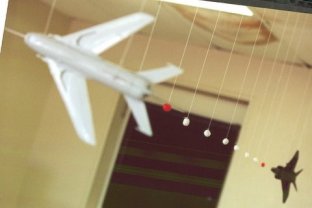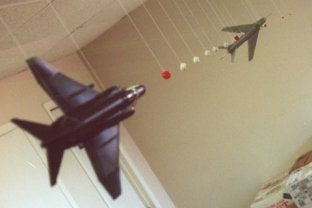


|
Postscript - Cover Art
The painting shown on the cover is from the easel of noted Canadian artist,
Rich Thistle. Working from charts, diagrams, pictures, models and innumerable
exchanges with the author, he dramatically captured a historically significant
instant of aerial combat with stunning accuracy. |
 |
|
| This drawing is to exact scale. It shows the relative positions of the
aircraft as well as the bullet stream for a 0.15 second interval (during
which time the MiG flew through that bullet stream).
The F-4 is 63' long and is traveling at 1,363 feet per second. The MiG-19 is 42' long and traveling at 833 feet per second. Fifteen bullets are in flight, with bullet #16 just leaving the muzzle of the M61 cannon which is firing 100 bullets per second. Bullets #1, #8, and #15 are tracer rounds and should be visible on the painting. At the instant shown, bullet #6 (the 3rd to hit) is just striking the
MiG in the right wing root area. 1/100th second earlier, bullet #5 explodes
the canopy, and 2/100th second earlier bullet #4 hits the left tip of
the MiG's nose. 1/100th second after the instant shown, bullet #8 will
hit the right fight stabilator. |
 |